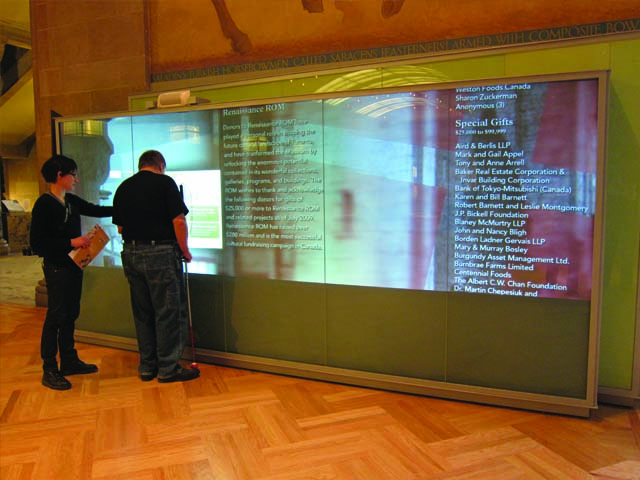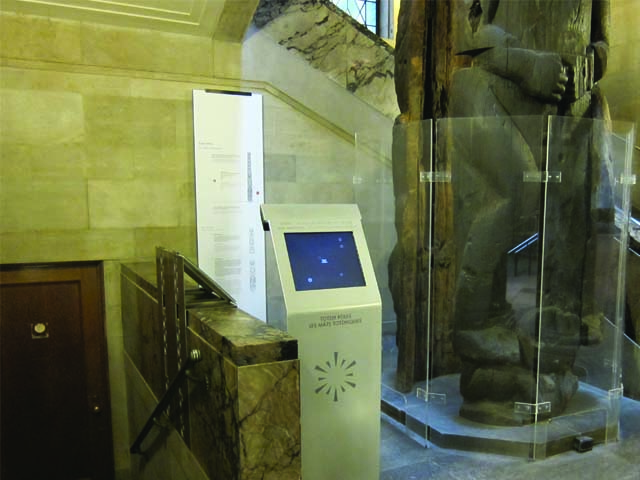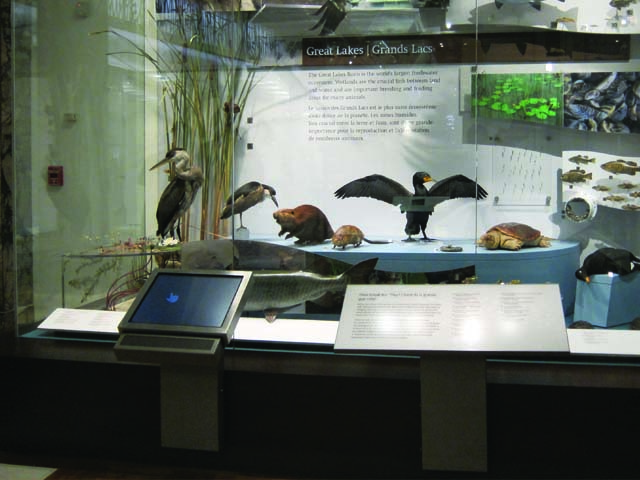Notes from chat with blind user about museum kiosk experience (January 13, 2010)
On January 13, 2010, we visited the ROM with a blind user (herein referred to as U1) to discuss what blind users look for in a museum experience, particularly about kiosk accessibility. Some direct questions from us are indicated in purple.
ROM lobby kiosk/interactive
- Re: ROM lobby kiosk/interactive:
- Doesn't give an idea of what's on there or what it contains, from a blind user's point of view; nothing to indicate its function
- Nothing to indicate its use: no borders, buttons, or any tangible physical pieces to indicate where the kiosk elements are
- This kiosk is "useless to me [U1]"
- Ideally there would be physical buttons, and even then, U1 would need to "hunt and peck"
- There needs to be a logic of where and how to begin
- Buttons or some other tactile element would be U1's starting point
- Audio instructions of "start here, do this" would be helpful
- How would you know what buttons do what?
- U1 would look for one button that stood out alone, and start by pressing that one
- That lone button would possibly sit above or below all the others
- Tactile elements on the button itself (embossments), such as a dot on the button (as on many 'F' and 'J' keys on keyboards, or the number '5' on a keypad) would help to indicate significance
ROM totem pole kiosk
- Re: ROM totem pole kiosk
- This kiosk served just one function: playing a video, which was activated by selecting a language
- Similarily unusable without buttons or another indicator of what it offers
- Content has audio commentary; this is useful
- Physically, the kiosk is much smaller than the lobby kiosk--easier to feel the borders
- Straightforward use, few options, makes it easy
- Could have made this kiosk very easily blind-user accessible by having a raised button to activate it
- Placing the buttons along the border of the kiosk display would have been good
ROM Schad Gallery kiosk
- Re: ROM Schad Gallery kiosk
- This kiosk presented a multitude of videos, selectable via touch screen with a 4x5 grid of video thumbnails
- How would we make this accessible?
- Automated telephone system-like would be easy
- Navigate through the videos with a numeric keypad
- "For English, press 1. Pour le francais, appuillez sur le 2."
- "For video on ____, press 1," etc.
- Navigate through the videos via voice (again, a la automated telephone system)
- Or, "For English, press the left switch", etc.
- Audio instructions on how to navigate/use the system
General questions and notes
- What do you think of the iPhone model of touchscreen accessibility?
- "Not my first choice. I prefer buttons."
- "I'm not a techie."
- "But[, in the end,] could I make it work? Probably."
- What do you expect at the museum? What kind of museum experience do you look for?
- Expect very little; museums and galleries are unfriendly places most of the time [to blind visitors]
- Some exceptions: museums that have a lot of old pioneer stuff; these museums tend to let you touch stuff
- Why are most museums and galleries not great? Most of the stuff is behind glass cases
- Lectures, movies, programs:making these usable is another whole
piece of work
- Ideally: would like to be able to touch everything; lectures often rely too heavily on slides; art/sculpture classes are inclusive and allow blind visitors to participate
- Having replicas of all the objects [to touch] would be really nice
- How do you connect with content, as a blind visitor?
- With a really good, *detailed* explanation
- Want to know about the backstory: what led the artist to... why was it made... what was the artist trying to convey...
- Used to think paintings weren't a good medium for him; but U1's opinion changing on this: a good description goes a long way
- Re: audio wand experience (at different museums)
- Want better coverage of pieces (at King Tut AGO exhibit, ~10% object coverage)
- How did you know what code to enter into the wand?
- Needed someone (e.g., attendant) to relay it to him, or would have had to hunt and peck and see what came up
- What's the difference between listening to the audio tour at the museum and at home?
- Combination of the audio tour + the person or people U1's with creates the full experience
- Attendant's description of the artifact means a lot (+ ability to ask attendant about the object); makes a big difference
- Also, listening to conversations of nearby people allows U1 to piece together a good idea about the artifacts
- Each component gives a difference piece of the puzzle: object label/card + audio tour + person/people
- How often, if ever, do you visit a museum without someone with you?
- Almost never
- Exceptions: special events, tours with docents
- U1 spends a lot of time doing pre-visit planning, finding out if the museum is worthwhile to visit
- In theory, should be able to just show up spontaneously and visit w/ a tour guide, but sometimes tour guide isn't available or the tour guide isn't good. Thus, not taking the chance to show up spontaneously. Need to plan a lot to maximize fulfillment.
- Museum wayfinding via attendant
- What's reasonable for a blind user to expect from a museum visit?
- Tactile tours
- Audio descriptions
- Docents that are good describers
- Raised line drawings
- Object replicas


